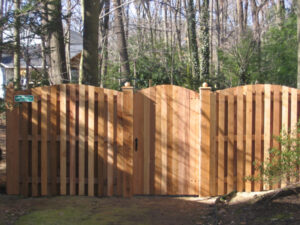
Pressure-treated wood fences are prone to warping over time. Why, and how can you prevent it?
Pressure-treated wood has become one of the most common materials used in all kinds of applications, including decking and fencing. It is due to its durability, termite protection, and rot resistance, all attributes that come with the pressure-treating process. However, that process can have some negative consequences as well. It’s not uncommon to see pressure-treated wood warping, which causes it to twist and become unstable.
If you want to avoid pressure-treated wood warping, it’s certainly possible. It’s not an issue that affects everyone, either. That said, before we get into how you can avoid pressure-treated wood warping, we have a few additional thoughts to dive into first.
Why Pressure-Treated Lumber?
When pressure-treated lumber first became available, it was made with a chemical called Chromated Copper Arsenic. Eventually, it was decided that it was too toxic, so lumber manufacturers stopped using that chemical and switched to others like Alkaline Copper Quaternary or Copper Azole. Regardless of what chemical is used, the process looks the same: the wood is placed into a tank to depressurize, removing any air in the wood, and then floods the vacuums left behind with chemicals. This process has its benefits, but it can add a lot of moisture to the wood.
Moisture Issues in Lumber
Once pressure-treated lumber is done with the chemical treatment process, it has to dry out some. However, builders will sometimes use this wood before it’s completely dry, hoping that the addition of nails and fasteners will prevent any warping. It’s not ideal, though, and it’s still possible for this to cause issues in the long haul. While that may not cause structural issues, it certainly isn’t going to look good. It’s also not uncommon to see checking, which is when the wood splits or splinters. Thankfully, these processes can be minimized.
Be Picky About Your Lumber
Plan ahead when choosing your lumber. Factors like the grain and pitch can affect twisting and splitting, though it’s also important to consider the grade and type of lumber. Look for lumber Grade 1 or higher, and check for a Kiln Dried After Treatment indicator. If your lumber carries both of these, it should mean that your wood will have a lower moisture content, meaning it is much less likely that your lumber will end up warping.
Get the Pressure-Treated Wood Fence of Your Dreams from Mid-Atlantic Deck & Fence
Mid-Atlantic Deck & Fence has almost 30 years of experience in building beautiful custom fences, gazebos, screened-in porches, and decks throughout the state of Maryland. We have the expertise to design your dream fence or custom deck and have it installed in a headache-free process. Give us a call at 1-800-833-9310 or visit us online for a quote today! We offer many different styles of fencing and decking, in addition to custom options designed specifically to suit your preferences and tastes. To see examples of our work and get more tips on how to choose the right decking for your family, follow us on Facebook, Twitter, Houzz, Pinterest, YouTube, and LinkedIn.
Tags: Pressure Treated Wood, pressure-treated wood care, pressure-treated wood warping








